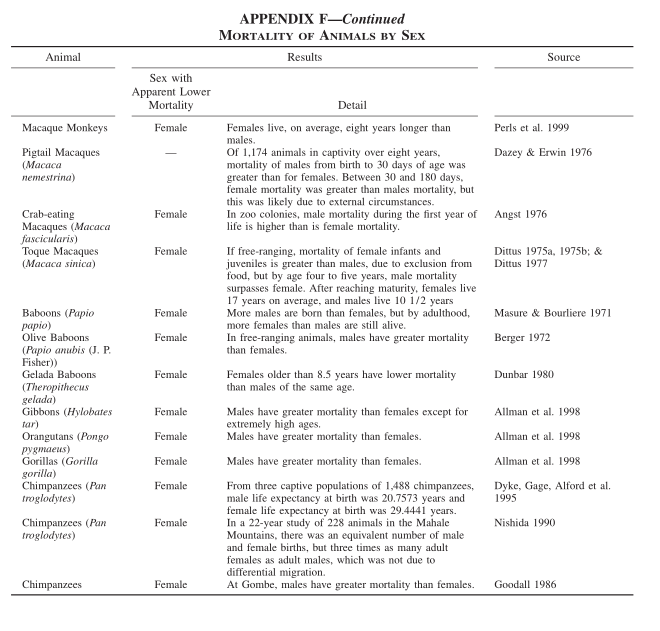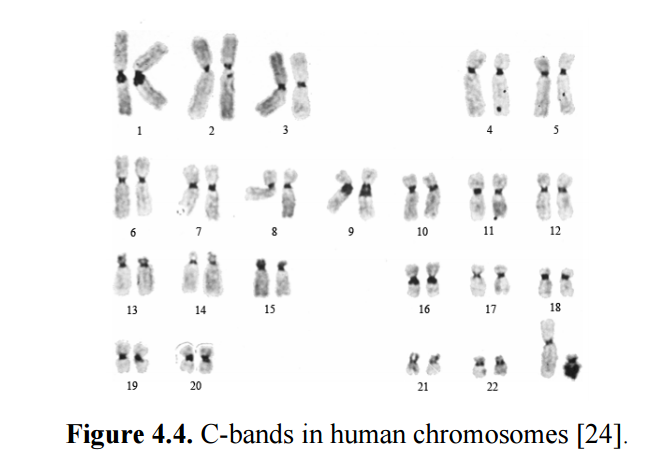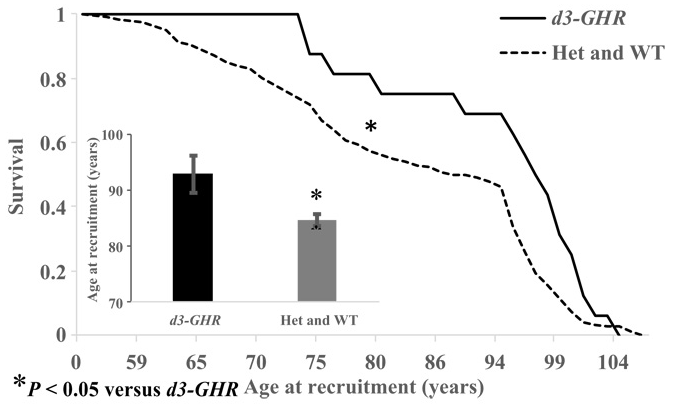Yromian chromosome, or why men die earlier?
Do you think it is only in men that men live less than women? Tell it to the mantis, he will laugh. Although no, there is nothing for him to laugh, the female ate his head after intercourse.
So, female individuals live longer in the vast majority of species known to science. For those who doubt this, I advise you to look at the 37 pages of data from the book Why there is a lot of difference, Sex , especially Appendix F - there are 100 kinds, not less:

And the statistics on different countries given in the same place is very illustrative (albeit for 1998):

Someone thinks that we, Y-beasts, live less women because we are so daring and sharp, and in our youth we are more susceptible to various dangerous nonsense such as riding motorcycles or playing American football. But this is not so - the probability of death in men is higher at any age, even in the quiet 60 and 70.
')
Therefore, intelligent people understand that the death of Kashcheyev lies in the ... Y-chromosome. Not without reason, castration prolongs life: in one American experiment by 20% (13.6 years), and in Korean eunuchs by 30–40% (15–19 years).
But the most interesting thing is that, perhaps, life extension can be achieved without castration! And simply by removing or epigenetically “turning off” certain “deadly genes” on the Y-chromosome itself. It was precisely in the 1980s that Bulgarian (Tsoneva) and Soviet (Kuznetsova) scientists established, studying male long-livers:
What are C-blocks? I will try to convey my understanding, but I would be very grateful for a more detailed explanation from the experts in the comments. So, in my understanding, in the case of the Y chromosome, C-blocks are inactive, “turned off” parts of the chromosome. Formally, C-blocks are those parts of the chromosome that are highlighted during the C-staining or C-banding procedure - processing of chromosomes with a special dye :

As I understand, these methods of different staining and subsequent highlighting of chromosomes were used in those ancient times when PCR technology did not exist (invented in 1983), gene sequencing was a long and expensive pleasure, and they had not even thought about identifying methylation patterns. Using different methods of illumination, it was possible to somehow differentiate the various structural and functional segments of the chromosomes. At one time, Soviet scientists were actively engaged in such analysis, in particular, the Y chromosome .
Specifically, the C-banding method usually highlights constitutive heterochromatin , which is a highly condensed DNA that is mainly present around the center or telomere. Since such DNA is highly compressed, it is not expressed, that is, these areas are not active. But in the case of the Y chromosome, in such a compressed state, she has almost all the DNA - see the lower right corner in the photo:

Such compression, or condensation , of chromatin occurs through the same mechanisms that are responsible for the standard epigenetic “shutdown” (inactivation) of genes. This inactivation occurs both at the level of histones and at the level of DNA methylation itself:
And so, if I correctly interpret their work, in the studies of Tsoneva and Kuznetsova, the long-livers in such a compressed state had a larger part of the Y chromosome than the control group, which makes me think that in this way they had epigenetically turned off then the genes that are usually active in the rest of the men, and with their activity they used to drive them to the grave.
A small lack of confusion for those who have stumbled over phrases like “epigenetically switched off” or “methylation” and generally vaguely imagine what epigenetics is. Epi genetics is a “superstructure” above ( epi- = above ) genetics, a mechanism for controlling genes. Rather, there are several such mechanisms: methylation of the genes themselves, acetylation or methylation of the histones on which these genes are “wound”, and many other things that fall under the definition of epigenetic control.
Why do genes even need to be controlled? Firstly, because the organism's DNA is the same in all cell types, and different sets of genes must be active in the brain and skin cells. And also because different genes are responsible for different stages of development of the organism — the caterpillar and the butterfly have a very different profile of the activity of these same genes. As with us, in fact: in the womb, some genes are active, in childhood - others, in old age - third ones. And by the way, with age, the profile on / off. different genes varies in all people almost equally. That formed the basis of the concept of “ methylation hours ” as an aging biomarker. But that's another topic.
So, going back to my hypothesis about marked genes on the Y-chromosome of Bulgarian and Soviet long-livers. What prompted me to this thought? And the fact that in 1987, geneticist Kirby Smith in America found 14 Amish men who had some genes removed on the Y chromosome and who lived 20% longer than their non-mutated brethren (82 years old against 68–71 years old):

Source: The Future of Aging: The Pathway to the Human Life Extension by Gregory M. Fahy, Michael D. West, L. Stephen Coles, Steven B. Harris
The most interesting thing is that the Y-chromosome is quite small: there are only 71 coding genes on it. Therefore, ideally, it would be very cool to figure out which areas were removed from these Amish. By the way, Kirby Smith is still alive and continues to work at Johns Hopkins University, and his DNA samples are likely to be preserved. To sequence them for him would be a simple matter - he is a professor of genetics there, after all. A couple of times I suggested to Gregory Fey (the author of that wonderful book on aging, from which I took the above table) to write to him again, but he is not eager yet.
Ziva and Svetlana Mikhailovna Kuznetsova, and even, as far as I can tell, continues to work at the D.F. Chebotarev in Kiev. I am thinking of writing to her too - all of a sudden she has DNA samples of those Soviet long-livers.
By the way, in the light of the above, it was interesting to hear about a recent study by a large fan of metformin Nira Barsilai , who showed that the deletion of the third exon in the growth hormone receptor has a positive effect on the life expectancy of men, but not women. After all, the age pattern of secretion and the levels of growth hormone in the sexes are very different, so maybe, in his research, a mechanism similar to the above-mentioned Y-mutants was manifested. Here is the survival curve of homozygous d3-GHR mutants compared with heterozygous and wild type:

True, the fact that some publications claim that the work of Barsilai and co. showed that homozygosity for d3-GHR helps to live for 10 years longer, wrong. Just at the beginning of his research, the average age (age at recruitment) of a subgroup of 16 homozygous subjects was 10 years higher than that of the other 180 members of the cohort. But, as can be seen from the graph of survival, the median pancreas of homozygous comrades is only 6–7 years higher than that of the control group, and the maximum is generally smaller.
In any case, the fact that the Y-chromosome conceals some secrets of potential longevity and doesn’t really want to reveal them to me yet seems to me more and more plausible.
So, female individuals live longer in the vast majority of species known to science. For those who doubt this, I advise you to look at the 37 pages of data from the book Why there is a lot of difference, Sex , especially Appendix F - there are 100 kinds, not less:

And the statistics on different countries given in the same place is very illustrative (albeit for 1998):

Someone thinks that we, Y-beasts, live less women because we are so daring and sharp, and in our youth we are more susceptible to various dangerous nonsense such as riding motorcycles or playing American football. But this is not so - the probability of death in men is higher at any age, even in the quiet 60 and 70.
')
Therefore, intelligent people understand that the death of Kashcheyev lies in the ... Y-chromosome. Not without reason, castration prolongs life: in one American experiment by 20% (13.6 years), and in Korean eunuchs by 30–40% (15–19 years).
But the most interesting thing is that, perhaps, life extension can be achieved without castration! And simply by removing or epigenetically “turning off” certain “deadly genes” on the Y-chromosome itself. It was precisely in the 1980s that Bulgarian (Tsoneva) and Soviet (Kuznetsova) scientists established, studying male long-livers:
“Previously, data on the relationship between large C-blocks on the Y chromosome and longevity among the Bulgarian population (Tsoneva et al., 1980), as well as data on the increased frequency of“ very large ”C-blocks in long-livers older than 80 years in Edinburgh, were published (Buckton et al., 1976).
...
The long Y chromosome, as well as the large C segment on the Y chromosome, are typical of long-lived Ukrainian and Abkhaz men. Thus, we have established a link between the variants of the individual variant of the chromosomal polymorphism on the Y chromosome and male longevity in different regions. ”
What are C-blocks? I will try to convey my understanding, but I would be very grateful for a more detailed explanation from the experts in the comments. So, in my understanding, in the case of the Y chromosome, C-blocks are inactive, “turned off” parts of the chromosome. Formally, C-blocks are those parts of the chromosome that are highlighted during the C-staining or C-banding procedure - processing of chromosomes with a special dye :

Other types of bands, such as R- and C-bands, can be obtained using the giemsa stain. The type of bands produced on the chromosome structure [10].
C-banding ... reveals the AT-rich centromere, which consists of a constitutive heterochromatin. This technique involves treatment of the chromosomes. These treatments depurinate the DNA and break the DNA backbone.
C-bands (figure 4.4) are produced. In the C-bands, it was observed to be more resistant to the chromosomes. It is a combination of the chromosomes [22].
( Source )
As I understand, these methods of different staining and subsequent highlighting of chromosomes were used in those ancient times when PCR technology did not exist (invented in 1983), gene sequencing was a long and expensive pleasure, and they had not even thought about identifying methylation patterns. Using different methods of illumination, it was possible to somehow differentiate the various structural and functional segments of the chromosomes. At one time, Soviet scientists were actively engaged in such analysis, in particular, the Y chromosome .
Specifically, the C-banding method usually highlights constitutive heterochromatin , which is a highly condensed DNA that is mainly present around the center or telomere. Since such DNA is highly compressed, it is not expressed, that is, these areas are not active. But in the case of the Y chromosome, in such a compressed state, she has almost all the DNA - see the lower right corner in the photo:

Such compression, or condensation , of chromatin occurs through the same mechanisms that are responsible for the standard epigenetic “shutdown” (inactivation) of genes. This inactivation occurs both at the level of histones and at the level of DNA methylation itself:
Histone modifications are the constitutive heterochromatin. [7] The three most common modifications are the histone hypoacetylation , the histone H3-Lys9 methylation (H3K9), and the cytosine methylation . These modifications are also found in other types of DNA, but much less frequently. Cytosine methylation is the most common type, although it is not found in all eukaryotes. In humans there is increased methylation at the centromeres and telomeres, which are composed of constitutive heterochromatin. These modifications can persist through both mitosis and meiosis and are heritable .
SUV39H1 is a DNA methyltransferase that methylates H3K9, providing a binding site for Heterochromatin protein 1 (HP1). HP1 is involved in the chromatin condensing process that makes DNA inaccessible for transcription. [eight]
[9]
And so, if I correctly interpret their work, in the studies of Tsoneva and Kuznetsova, the long-livers in such a compressed state had a larger part of the Y chromosome than the control group, which makes me think that in this way they had epigenetically turned off then the genes that are usually active in the rest of the men, and with their activity they used to drive them to the grave.
A small lack of confusion for those who have stumbled over phrases like “epigenetically switched off” or “methylation” and generally vaguely imagine what epigenetics is. Epi genetics is a “superstructure” above ( epi- = above ) genetics, a mechanism for controlling genes. Rather, there are several such mechanisms: methylation of the genes themselves, acetylation or methylation of the histones on which these genes are “wound”, and many other things that fall under the definition of epigenetic control.
Why do genes even need to be controlled? Firstly, because the organism's DNA is the same in all cell types, and different sets of genes must be active in the brain and skin cells. And also because different genes are responsible for different stages of development of the organism — the caterpillar and the butterfly have a very different profile of the activity of these same genes. As with us, in fact: in the womb, some genes are active, in childhood - others, in old age - third ones. And by the way, with age, the profile on / off. different genes varies in all people almost equally. That formed the basis of the concept of “ methylation hours ” as an aging biomarker. But that's another topic.
So, going back to my hypothesis about marked genes on the Y-chromosome of Bulgarian and Soviet long-livers. What prompted me to this thought? And the fact that in 1987, geneticist Kirby Smith in America found 14 Amish men who had some genes removed on the Y chromosome and who lived 20% longer than their non-mutated brethren (82 years old against 68–71 years old):

Source: The Future of Aging: The Pathway to the Human Life Extension by Gregory M. Fahy, Michael D. West, L. Stephen Coles, Steven B. Harris
The most interesting thing is that the Y-chromosome is quite small: there are only 71 coding genes on it. Therefore, ideally, it would be very cool to figure out which areas were removed from these Amish. By the way, Kirby Smith is still alive and continues to work at Johns Hopkins University, and his DNA samples are likely to be preserved. To sequence them for him would be a simple matter - he is a professor of genetics there, after all. A couple of times I suggested to Gregory Fey (the author of that wonderful book on aging, from which I took the above table) to write to him again, but he is not eager yet.
Ziva and Svetlana Mikhailovna Kuznetsova, and even, as far as I can tell, continues to work at the D.F. Chebotarev in Kiev. I am thinking of writing to her too - all of a sudden she has DNA samples of those Soviet long-livers.
By the way, in the light of the above, it was interesting to hear about a recent study by a large fan of metformin Nira Barsilai , who showed that the deletion of the third exon in the growth hormone receptor has a positive effect on the life expectancy of men, but not women. After all, the age pattern of secretion and the levels of growth hormone in the sexes are very different, so maybe, in his research, a mechanism similar to the above-mentioned Y-mutants was manifested. Here is the survival curve of homozygous d3-GHR mutants compared with heterozygous and wild type:

True, the fact that some publications claim that the work of Barsilai and co. showed that homozygosity for d3-GHR helps to live for 10 years longer, wrong. Just at the beginning of his research, the average age (age at recruitment) of a subgroup of 16 homozygous subjects was 10 years higher than that of the other 180 members of the cohort. But, as can be seen from the graph of survival, the median pancreas of homozygous comrades is only 6–7 years higher than that of the control group, and the maximum is generally smaller.
In any case, the fact that the Y-chromosome conceals some secrets of potential longevity and doesn’t really want to reveal them to me yet seems to me more and more plausible.
Sources:
- Why Men Die Younger: Causes of Mortality Differences by Sex. Barbara blatt kalben
- The Future of Aging: The Path to Human Life Extension. Gregory M. Fahy, Michael D. West, L. Stephen Coles, Steven B. Harris
Source: https://habr.com/ru/post/373565/
All Articles